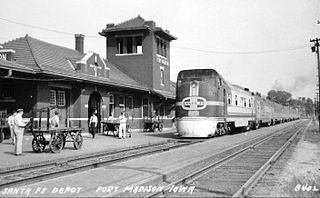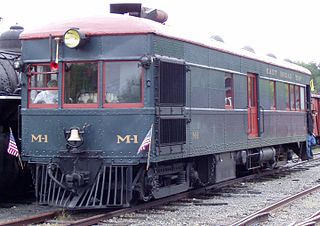
A streamliner is a vehicle incorporating streamlining in a shape providing reduced air resistance. The term is applied to high-speed railway trainsets of the 1930s to 1950s, and to their successor "bullet trains". Less commonly, the term is applied to fully faired upright and recumbent bicycles. As part of the Streamline Moderne trend, the term was applied to passenger cars, trucks, and other types of light-, medium-, or heavy-duty vehicles, but now vehicle streamlining is so prevalent that it is not an outstanding characteristic. In land speed racing, it is a term applied to the long, slender, custom built, high-speed vehicles with enclosed wheels.

The Atchison, Topeka and Santa Fe Railway, often referred to as the Santa Fe or AT&SF, was one of the largest Class 1 railroads in the United States between 1859 and 1996.

The Super Chief was one of the named passenger trains and the flagship of the Atchison, Topeka and Santa Fe Railway. The then-modern streamliner was touted in its heyday as "The Train of the Stars" because it often carried celebrities between Chicago, Illinois, and Los Angeles, California.

Electro-Motive Corporation produced five 1800 hp B-B experimental passenger train-hauling diesel locomotives in 1935; two company-owned demonstrators, #511 and #512, the Baltimore and Ohio Railroad's #50, and two units for the Atchison, Topeka and Santa Fe Railway, Diesel Locomotive #1. The twin engine power unit layout and multiple unit control systems developed with the B-B locomotives were soon adopted for other locomotives such as the Burlington Route's Zephyr locomotives built by the Budd Company in 1936 and EMC's own EMD E-units introduced in 1937. The B-B locomotives worked as proof-of-concept demonstrators for diesel power with the service loads of full size trains, breaking out of its niche powering the smaller custom Streamliners.
In 1948, 14 railroads in North America owned more than 1,000 steam locomotives each. See also: Historical sizes of railroads

Doodlebug or hoodlebug is a nickname in the United States for a type of self-propelled railcar most commonly configured to carry both passengers and freight, often dedicated baggage, mail or express, as in a combine. The name is said to have derived from the insect-like appearance of the units, as well as the slow speeds at which they would doddle or "doodle" down the tracks. Early models were usually powered by a gasoline engine, with either a mechanical drive train or a generator providing electricity to traction motors ("gas-electrics"). In later years, it was common for doodlebugs to be repowered with a diesel engine.
The El Camino was a set of lightweight streamlined railcars owned by Los Angeles County in the 1970s and 1980s. The county acquired the cars to bootstrap a proposed commuter rail service between Los Angeles and Orange County. This effort, spearheaded by County Supervisor Baxter Ward, was unsuccessful. The equipment saw limited use on Amtrak's San Diegan in 1978 and was sold in 1985.







